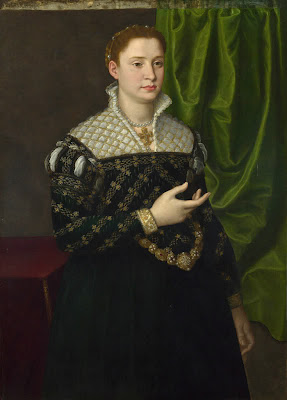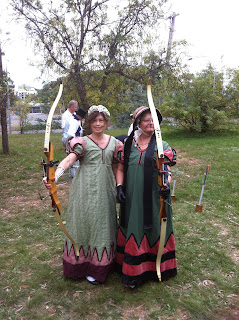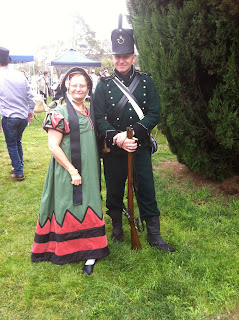 |
Unknown Woman,
National Portrait Gallery,
London |
The lovely Bela of the Realm of Venus is running the
Italian Renaissance Costuming Challenge once again. I attempted to enter last year, but I chose a too early period and so didn't enter, though I did make the outfit.
This year I have decided to give it another go and have chosen the beautiful gown in the portrait on the left, Portrait of an Unknown Woman, held in the National Portrait Gallery, London.
The gown is elegant and relatively simple in design and style. The base fabric is a dark green, I'm presuming velvet. Then there is the lovely embroidered ribbon trim on both bodice and sleeves, with slashes between the embroidery showing a second layer of green, I'm presuming silk.
The very pretty partlet of gold and pearls makes the gown I think and the lovely necklace and the waist belt add bling and dash.
The IRRCC 2 challenge
Layer 1: A camicia/shift/smock/shirt or drawers or corset/pair of bodies. I don't expect you to make all three, however one item MUST be an underwear layer.
I'm making a new camica.
Layer 2: Either an underskirt or under-dress/petticoat, or doublet and slops.
For me its an under-dress/petticoat
Layer 3: The final layer will be either an over-dress, or a loose gown, or a cloak/cape.
The above gown for me.
Layer 4: An accessory - any one of the following: fan, pocket/pouch, hat/jewelled accessory for the hair, zibellino (also known as a "flea fur"), hanky, gloves, girdle, shoes, partlet, a set of Venetian shoulder/neck ruffs (if they are separate from the partlet), standing ruff/collar, parasol, and muff.
I'm making the beautiful partlet in the above portrait. If I have time I will also make the necklace and the lovely gold belt.
00000~~~~~00000
I am heading to London in the last week of August and I hope to wear the gown to the National Portrait Gallery and have my photo taken next to the portrait, that's if its not off on a world tour or something! So wish me luck and watch my progress as I pootle along.
00000~~~~~00000
Layer 1: Camicia

I am using the camica on the left as my design basis for the project. Its earlier than my gown, around 1520, however, the tight sleeves of the gown need less bulk to feel comfortable.
Another costumer also inspired me with her version of this camica with beautiful machine black work on Live Journal
DressDiaries, made to go with a 1560s gown.
Also, seeing her machine black work embroidery I was inspired to try it.
Now, I don't do embroidery, I'm a plain sewing type of gal and hand
embroidery isn't an option and my Pfaff has very limited stitches
available. But I chose some stitches and I think they pass
muster.
You can also see how I pleated my sleeve cuffs that go up to just below my elbow
Camicia finished, I'm very pleased with the black work embroidery from my Pfaff and I love the pleated sleeves and how it creates the pleated cuffs.
Layer 2 - Petticoat

For the petticoat I am using the pattern from The Tudor Tailor, the
'braces' style, yes I know, English not Florentine, but I will get more
wear out of it, so I am an English lady visiting Florence with her Diplomat husband, using her own
underpinings.
So here is my front bodice pattern to give you an idea of the 'braces'
Back view of petticoat.
Layer 3 - Gown
The
bodice for my gown has been drafted using a number
of source texts such as Janet Arnold's Pattern of Fashion and The Tudor
Tailor, plus I used a previous bodice draft from an earlier Tudor gown
and a earlier period Italian Renaissance gown. It will be side back laced.
I
haven't decided whether I shall use rope or cable ties for my bodice
boning, I don't want it too stiff and I want a soft rounded front so I
think rope will win out, with perhaps a few cable ties at the seams and
lacing edges for strength.
Layer 4 - Partlet

I have used
Festive Attyre's partlet pattern to create my own, I love this website, such a fabulous resource.
I want to replicate the ruching on the original, so I made the partlet larger to accomodate the gathering, here's my test toile
I found if I followed the lines of the partlet shoulder seams I ended by with diagonal ruching lines, which will work well with the overlay ribbon pattern, I wonder if this is why the original one's ribbons are placed on the diagonal?I was lucky to find a small piece of sheer silk in my stash, thought I was going to have to use linen. Love my stash, full of unexpected delights!

Front view, gathered.
So I gathered the silk and it turned out well, the silk is really soft so I am going to have to use either boning or interfacing for the collar so it will sand out like the painting.
Back view, gathered.
As I have no view of the back of the partlet, I am guessing its construction. I gathered each of the back pieces following the shoulder lines separately and then stitched them together.

Gathering completed on all pieces of the partlet, french seames at all seams. Next to lay the gold cord diamond pattern. I had bought gold ribbon for this but it was too wide and I didn't like the effect, so now I am using gold cord which does resemble the original, though my diamond pattern is wider. Now to hand sew it all on, a lovely 'in front of telly' task.







































